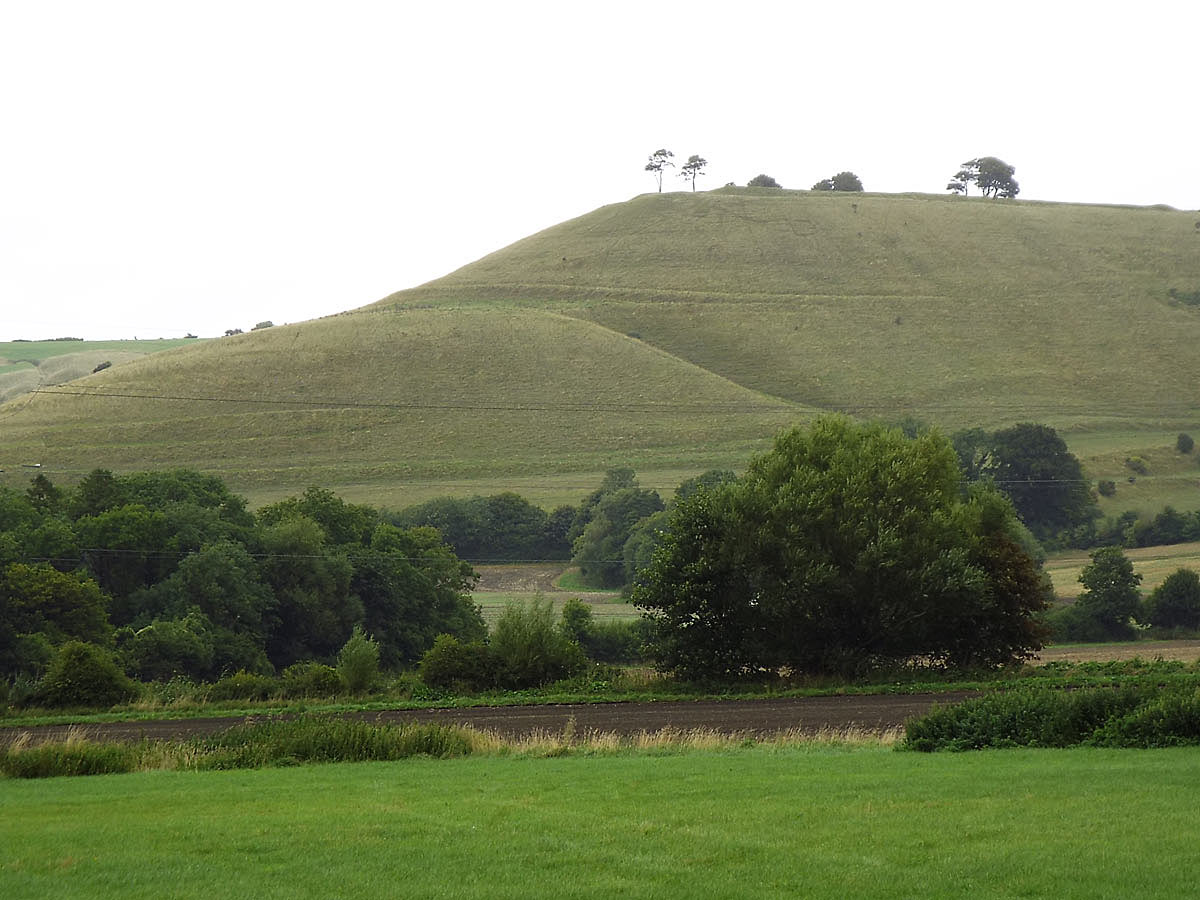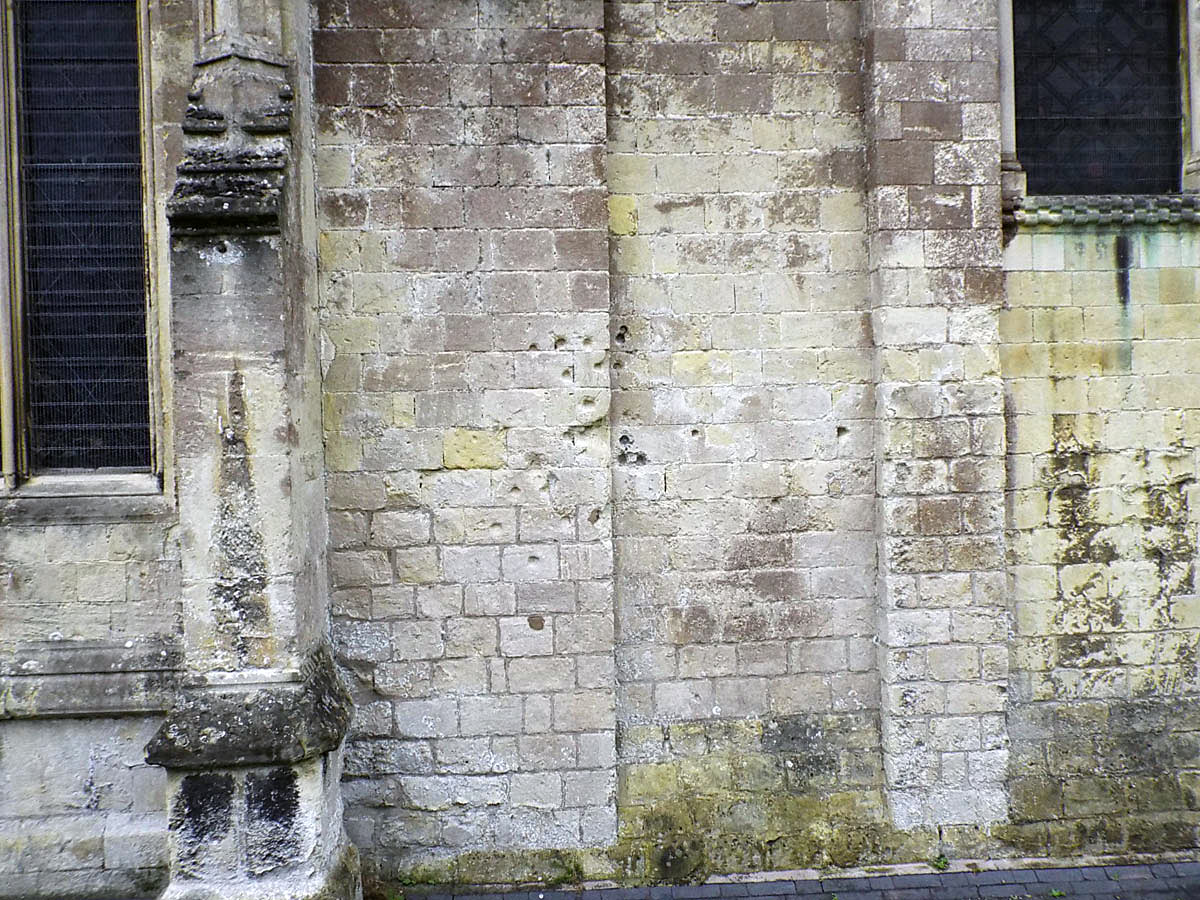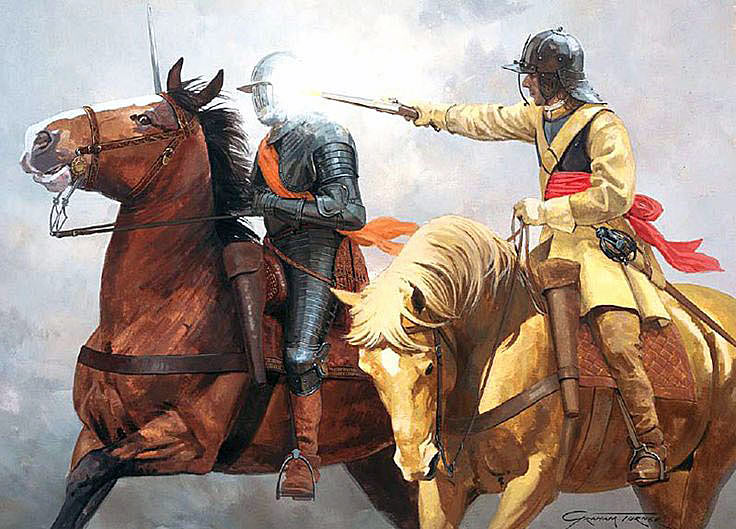The remarkable Royalist cavalry victory in the west of England, fought on 13th July 1643
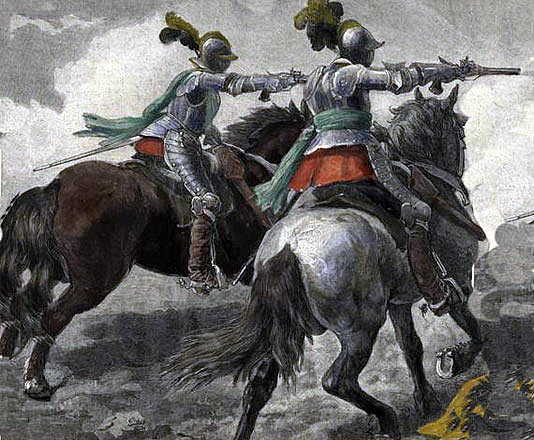
Sir Arthur Hesilrige’s Cuirassiers, known as ‘Hesilrige’s Lobsters’. Hesilrige’s ‘Lobsters’ were driven off the field at the English Civil War Battle of Roundway Down on 13th July 1643 by Lord Wilmot’s Royalist Horse
The previous battle in the English Civil War is the Battle of Lansdown Hill
The next battle in the English Civil War is the Storming of Bristol
To the English Civil War index
Battle: Roundway Down
War: English Civil War
Date of the Battle of Roundway Down: 13th July 1643
Place of the Battle of Roundway Down: To the north of Devizes in Wiltshire.
Combatants at the Battle of Roundway Down: The forces of King Charles I against the forces of Parliament

Lord Wilmot, Royalist Commander at the Battle of Roundway Down on 13th July 1643 during the English Civil War
Generals at the Battle of Roundway Down: Lord Wilmot commanded the Royalist force advancing from Oxford to relieve Sir Ralph Hopton who commanded the Royalist force in Devizes. Sir William Waller commanded the Parliamentary force besieging Devizes.
Size of the armies at the Battle of Roundway Down: Lord Wilmot’s three brigades of Royalist horse, his own, Sir John Byron’s and Lord Crawford’s with a contingent commanded by Prince Maurice comprised 1,800 men with two small ‘galloper guns’. Sir Ralph Hopton’s Royalist garrison in Devizes numbered around 3,000 Cornish foot with a number of guns.
Sir William Waller’s army comprised 6 regiments of horse comprising 2,000 men, 4 regiments of foot (musketeers and pike men) comprising 2,500 men and 8 field guns.
Winner of the Battle of Roundway Down: Wilmot Royalist cavalry defeated Waller’s Parliamentary army.
Uniforms, arms and equipment at the Battle of Roundway Down:
See this section in the Battle of Edgehill.
Background to the Battle of Roundway Down:
The origins of the English Civil War are dealt with under this section in the Battle of Edgehill .
In 1643 the Royalist Commander Sir Ralph Hopton marched his force of experienced and effective Cornish infantry into Somerset to join the Royalist force of Lord Hertford and Prince Maurice sent from Oxford by King Charles I to subdue the West Country.
The Royalist army met the Parliamentary army of Sir William Waller at the Battle of Landsdown to the south-east of Bath. While the Royalists managed to force their way onto Landsdown Hill and push back Waller’s men from the brow of the hill the battle left them short of ammunition and the Royalist horse in a bad way due to extensive desertions during the battle.
The next day the Royalist army withdrew a short distance. There was then an accidental explosion in which one of the Royalist’s last cartloads of black powder was detonated. Hopton was badly injured and a considerable amount of ammunition lost.

Sir Ralph Hopton, commander of the Royalist Foot in Devizes at the Battle of Roundway Down on 13th July 1643 during the English Civil War
This incident precipitated a Royalist retreat, pursued by Waller with re-enforcements from the Bristol garrison, to Devizes in Wiltshire.
On 10th July 1643 Waller’s Parliamentary army was drawn up on Roundway Down to the north of Devizes. Rather than give battle the Royalist force remained in Devizes and established itself in the town and castle.
The Royalist commanders held a council of war, attended by the temporarily blinded and disabled Hopton carried in a chair. It was decided that Lord Hertford and Prince Maurice would march to Oxford with the horse while Hopton held Devizes with the infantry and guns.
Lord Hertford and Prince Maurice left the same evening, marched the forty-five miles to Oxford during the night and arrived in Oxford during the morning of 11th July 1643.
King Charles had already dispatched an ammunition train and a force of cavalry commanded by Lord Crawford on 9th July and Lord Wilmot’s brigade of horse on 10th July to reinforce the Western Army at Devizes.
On 12th July Prince Maurice set out from Oxford for Devizes with his cavalry and Lord Byron’s brigade of horse.
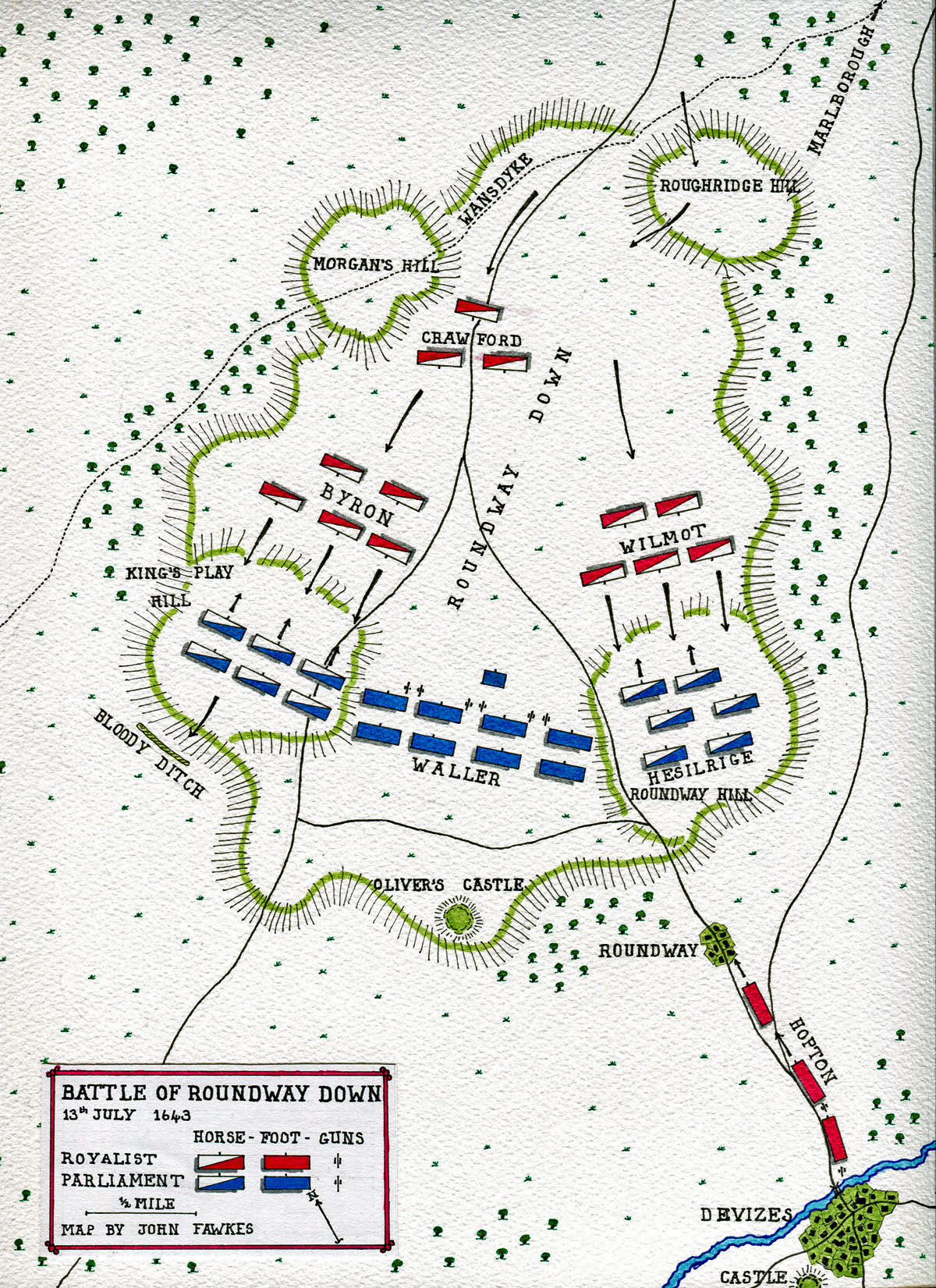
Map of Battle of Roundway Down fought on 13th July 1643 during the English Civil War: map by John Fawkes
Account of the Battle of Roundway Down:
Sir William Waller with his Parliamentary army spent 11th July 1643 bombarding Devizes, which Hopton’s Cornish infantry had put into a form of defence by barricading the streets, and the castle.
On 12th July Waller sent in a trumpeter to call on Hopton to surrender the town, informing him that he had intercepted the relieving ammunition train and captured the supplies. Hopton kept the negotiations going for the rest of the day to enable the relieving Royalist army to come up and to enable his troops to rest.
Once the terms were rejected Waller launched an assault on the town which was driven back by the Royalist troops.
Waller resolved to assault Devizes again on 13th July after a heavy preliminary bombardment conducted from a hill to the east of the town.
The Parliamentary barrage had scarcely begun when Waller received the unexpected news that Royalist troops were approaching from the north.

Prince Maurice of Nassau, the Royalist commander who took his cavalry 45 miles to Oxford to bring back the relief for Hopton’s force in Devizes, leading to the Battle of Roundway Down on 13th July 1643 during the English Civil War: picture by Gerrit van Honthorst
Lord Wilmot was advancing from the direction of Marlborough with 1,500 Royalist horse of his brigade, Byron’s brigade, Crawford’s troopers, who had already been driven back from Devizes, and Prince Maurice’s men who had arrived in Oxford and promptly turned round to ride back to relieve their comrades with Hopton in Devizes.
Wilmot’s Royalist mounted force passed through a sheep gap in the old ditch and rampart called the Wansdyke which runs south-east to north-west and climbed onto Roughridge Hill which forms the south-east corner of Roundway Down to the north of Devizes, pausing to fire two cannon shots as a signal to the garrison in the town that their relief was present. The Royalists in Devizes castle heard the two shots and fired two in return.
In response to Wilmot’s imminent threat Sir William Waller abandoned the attack on Devizes and marched his Parliamentary army up onto Roundway Hill which forms the south-west portion of Roundway Down, confronting Wilmot’s cavalry as they advanced up the slope from Roughridge Hill.
Waller formed his army in the conventional manner with his infantry line in the centre and cavalry on each flank. Waller placed Hesilrige’s regiment of cuirassiers on the right wing. The eight guns were positioned to the front of the infantry line.
Wilmot brought his Royalist cavalry on, his own brigade leading on the left followed by Sir John Byron’s brigade on his right and Crawford’s troopers, still shaken by the mauling they had received in Waller’s attack on the ammunition column, in the rear. All these mounted troops had ridden forty-five miles through the night and Prince Maurice’s men had ridden the additional forty-five miles from Devizes to Oxford before leaving with Wilmot.
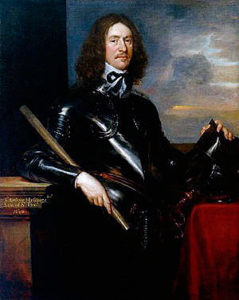
Sir Arthur Hesilrige whose cuirassiers were routed by Lord Wilmot’s Royalist brigade of horse at the Battle of Roundway Down on 13th July 1643 during the English Civil War
Hesilrige’s cuirassiers were clearly considered by the Parliamentary side to be something of a trump card, heavily armoured as they were (the regiment’s nickname on both sides was ‘Hesilrige’s Lobsters’, a reference to the interlocking plates at the back of the helmets covering the troopers’ necks and on the thigh pieces). Clarendon in his ‘History of the Great Rebellion’ referred to Hesilrige’s men as ‘this Impenetrable Regiment’.
In Devizes the senior Royalist officers held a council of war and decided that there was too great a danger that the circumstances were a stratagem of Waller’s to lure them out of their fortifications. They refused to move, in spite of the urgings of the wounded Hopton to join the battle without delay. A messenger from Wilmot urging Hopton to join the attack on the Parliamentary force had failed to arrive presumably having been captured. Wilmot was left to fight the battle with only his force of horsemen.
The attack was begun by the Royalist forlorn hope led by Major Paul Smith which drove the opposing forlorn hope back onto the main Parliamentary army. Wilmot followed up this initial success with his whole front line, his own brigade in advance of Byron’s.
Hesilrige’s cuirassiers, formed six deep, advanced to meet Wilmot, whose brigade formed three deep outflanked them on each wing, and after a stiff melee were driven back by Wilmot’s men.
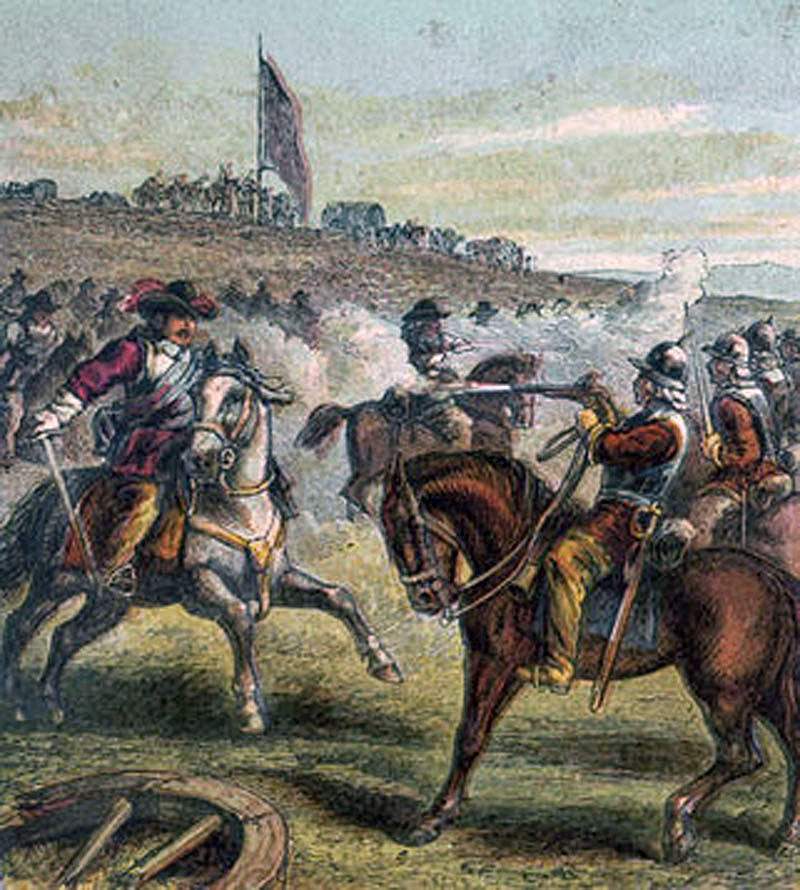
Lord Wilmot’s horse (left) attacks Sir Arthur Hesilrige’s ‘Lobsters’ (right) at the Battle of Roundway Down on 13th July 1643 during the English Civil War
It seems very likely that Hesilrige’s Lobsters made the classic mistake of receiving Wilmot’s charge stationery. They may well have halted to give fire with pistols and carbines while the Royalist cavalry charged home. Armour, firearms and even heavier horses would not assist against a charge, even uphill by determined horsemen well led and of high morale. Hesilrige’s regiment dissolved and fled the field.
The advance of Hesilrige’s cuirassiers masked the Parliamentary guns so that they were unable to fire before being overwhelmed by Wilmot’s victorious brigade.
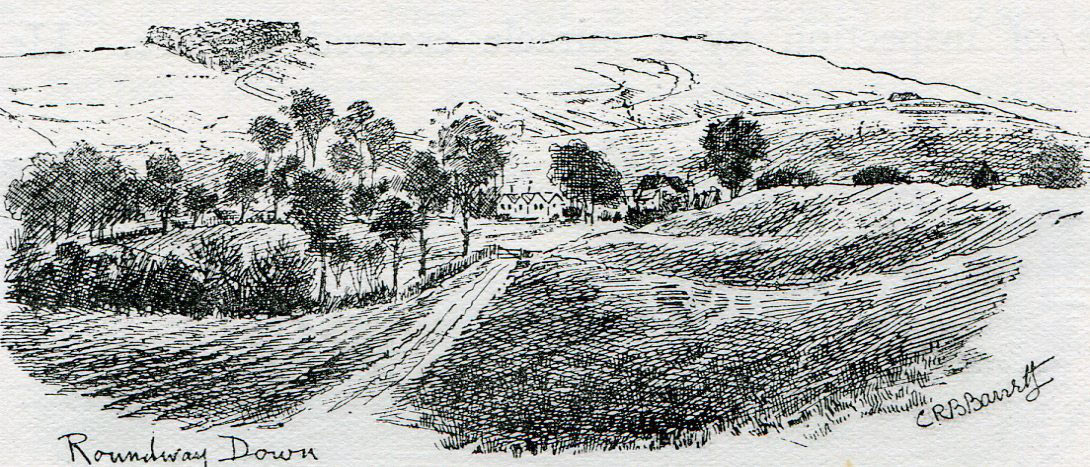
Scene of the Battle of Roundway Down on 13th July 1643 during the English Civil War: drawing by C.R.B. Barrett
On the other wing Sir John Byron’s Royalist brigade charged uphill into Waller’s brigade which stood to receive them with pistol fire. Byron’s men charged home, having emphatic instructions not to return pistol fire, and after a struggle drove Waller’s men back onto the second line, the whole mass being driven off the field.
The Royalist horse pursued Waller’s men for several miles until they reached a steep precipice over which many of the troopers of both sides fell to their and their horses’ deaths. The drain at the bottom of the cliff became ‘the Bloody Ditch’.
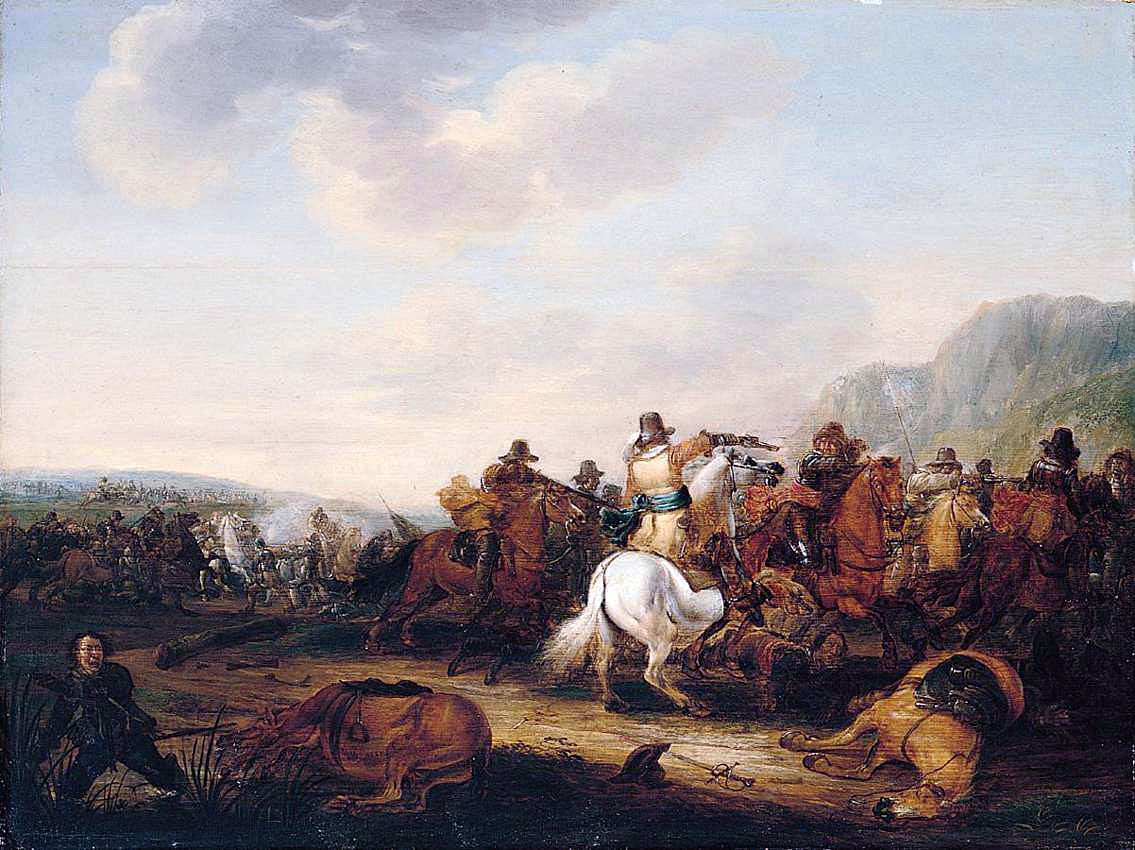
Cavalry action at the time of the English Civil War: Battle of Roundway Down on 13th July 1643 during the English Civil War
On the battlefield those of Wilmot’s and Byron’s brigades who had remained attacked the Parliamentary foot, turning the captured guns on them.
Initially the Parliamentary foot stood firm and began to manoeuvre off the battlefield.
The Cornish foot of the Devizes garrison, convinced by the clear signs of fighting that there was no ruse, was marching with as much speed as possible to join the battle. As they came up the road and over Roundway Hill the remaining Parliamentary foot began to dissolve, the officers riding off and the soldiers either taking to their heels or surrendering.
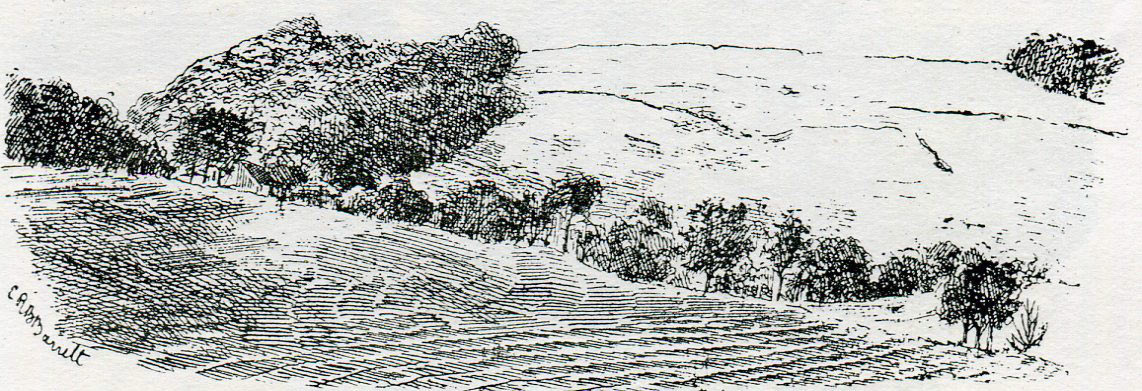
Roundway Down east side: Battle of Roundway Down on 13th July 1643 during the English Civil War: drawing by C.R.B. Barrett
Waller’s army ceased to exist leaving the Royalist troops victorious.
Casualties at the Battle of Roundway Down:
Casualty figures for Waller’s Parliamentary army are largely a matter of conjecture as it was effectively destroyed. Many survivors simply went home and took no further part in the war, at least for some time. Waller took the rump that remained at the colours to join the Parliamentary garrison in Bristol.
Royalist casualties were probably around 200.
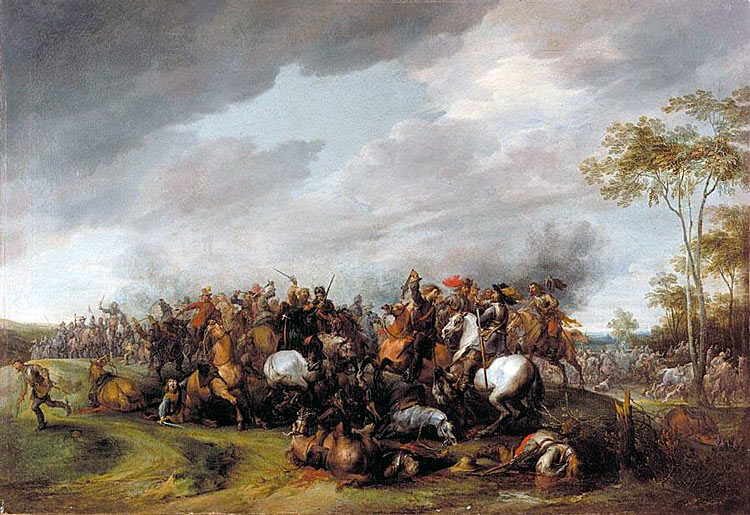
Cavalry action at the time of the English Civil War: Battle of Roundway Down on 13th July 1643 during the English Civil War: picture by Peter Sneyers
Follow-up to the Battle of Roundway Down:
Roundway Down is considered the most successful Royalist battle of the English Civil War.
Following the Battle of Roundway Down King Charles dispatched Prince Rupert with a strong army to the West. Rupert joined up with the Western Army and then on 26th July 1643 stormed the City of Bristol.
Waller, after withdrawing to Gloucester returned to London.
Regimental anecdotes and traditions from the Battle of Roundway Down:
- Before the Battle of Roundway Down Sir William Waller was so confident that he was about to receive the surrender of Hopton’s force in Devizes that he wrote to the Parliament saying ‘the business is done and by the next post I will send you the number and rank of my prisoners’.
- Waller had no expectation that King Charles would be able to send any relief from Oxford as the Earl of Essex was close by with his Parliamentary army at Thame. The force under Wilmot comprised a substantial proportion of the Royalist horse and sending it was a considerable risk, entirely vindicated by the result.
- Sir William Waller blamed the Earl of Essex for his defeat by permitting such a strong contingent of cavalry to leave Oxford and head for the West Country. Essex blamed Waller for being beaten by such an inferior force. Relations between the two men were about as sour as they could be with a detrimental effect on the conduct of the war for Parliament.
- Due to their armour Sir Arthur Hesilrige’s Cuirassiers were known as ‘Hesilrige’s London Lobsters’. They were also known as Hesilrige’s Bluecoats. Individually the Royalist horse were unable to deal with these horsemen as they were unable to penetrate their armour with their swords and pistol bullets bounced off the armour plates. It is said that this regiment were the predecessors of the Royal Horse Guards now the Blues and Royals.
- During the rout of Hesilrige’s Cuirassiers Hesilrige himself was pursued remorselessly by Captain Richard Atkyns. Atkyns found his pistol bullets bounced off Hesilrige’s armour and he could make no impression with his sword. Eventually Atkyns disabled Hesilrige’s horse and made him prisoner. At this point several of Hesilrige’s men came up and rescued their commander.
- While under attack in Devizes the Royalist infantry ran low on ammunition and in particular were short of matches for their firelocks. Officers searched the town for bed cord which was beaten and boiled producing 15 hundredweight of new match, sufficient to continue the battle.
- Grant believes that Sir Ralph Hopton was the officer who rescued Elizabeth Stuart wife of the Elector Palatine and Queen of Bohemia after the Battle of the White Mountain and carried her on his saddle crop to Breslau in 1620.

Oliver’s Castle: Battle of Roundway Down on 13th July 1643 during the English Civil War: drawing by C.R.B. Barrett
References for the Battle of Roundway Down:
The English Civil War by Peter Young and Richard Holmes
History of the Great Rebellion by Clarendon
Cromwell’s Army by CH Firth
English Heritage Battlefield Report: Roundway Down 1643
British Battles by Grant Volume I
The previous battle in the English Civil War is the Battle of Lansdown Hill
The next battle in the English Civil War is the Storming of Bristol
To the English Civil War index
